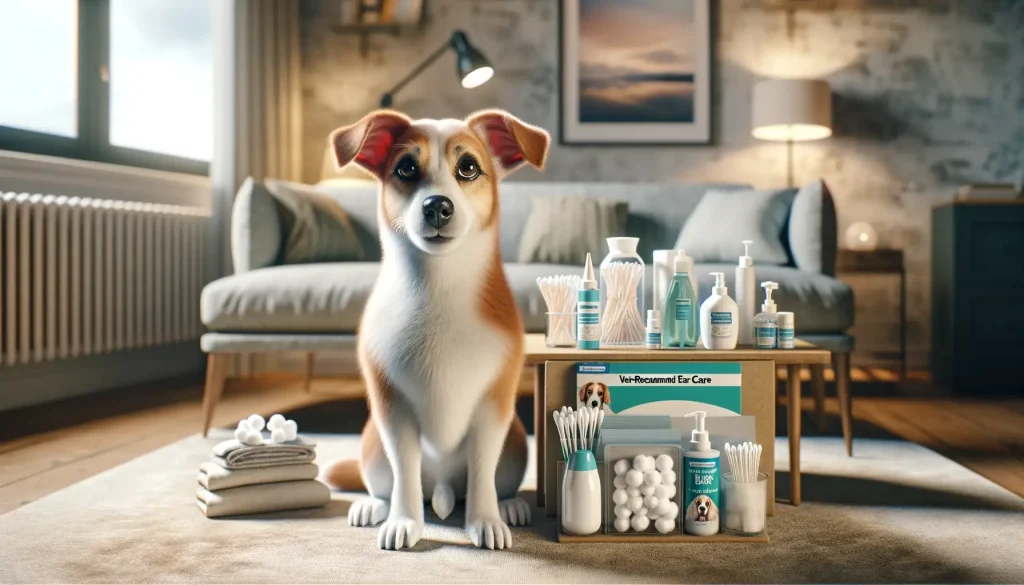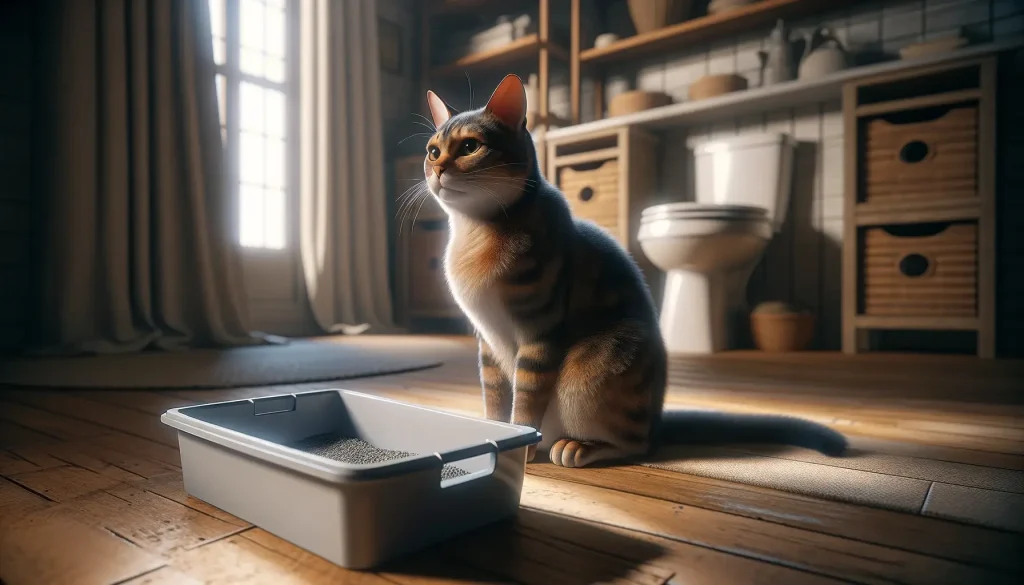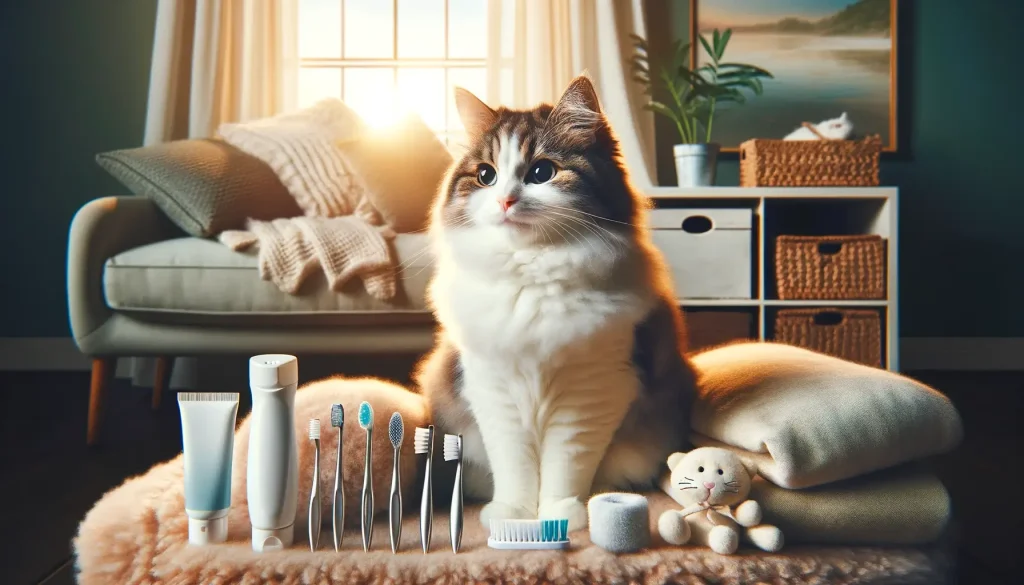
Cleaning Your Cat’s Teeth
Many cat owners overlook dental hygiene for their feline friends, not realizing the impact it can have on their overall health. If the thought of your cat’s breath smelling less than fresh makes you wince, you’re not alone. A common sign of neglected dental care is bad breath, which can indicate underlying health issues. Brushing your cat’s teeth might sound daunting, but it’s a necessary step in preventing periodontal disease, plaque, and tartar buildup. With the right tools and a bit of patience, keeping your cat’s teeth clean and healthy is easier than you think.
Did you know that not brushing your cat’s teeth can lead to a buildup of plaque, transforming into tartar, and ultimately causing periodontal disease? This not only affects their oral health but can lead to more serious health issues. Daily brushing can significantly reduce these risks, and pairing it with annual professional cleanings can help ensure your cat’s mouth stays healthy. What tools will you need, and how can you make brushing a routine that both you and your cat are comfortable with?
Brushing Your Cat’s Teeth
Brushing your cat’s teeth every day is vital in preventing the build-up of plaque and tartar. Adequate dental care, including daily brushing and annual professional cleanings, safeguards your cat against periodontal disease and promotes overall health. But what exactly are plaque, tartar, and periodontal disease, and how do they affect your cat?
- Plaque: A sticky, colorless film of bacteria and sugars that forms on teeth. It’s the precursor to tartar and can be managed with regular brushing.
- Tartar: If plaque isn’t removed, it hardens into tartar, a brown or yellow deposit at the base of the tooth. Tartar needs professional dental cleaning to be removed.
- Periodontal Disease: The direct result of untreated plaque and tartar build-up leading to a serious infection that damages the gums and can destroy the jawbone.
To ensure you’re equipped for the task, you’ll need a few specific tools. A cat-sized toothbrush or a finger brush, and pet-safe toothpaste are essential for a successful brushing routine. It’s crucial to note that human toothpaste is harmful to cats and should never be used. Instead, opt for flavors designed to appeal to cats, making the brushing experience as pleasant as possible.
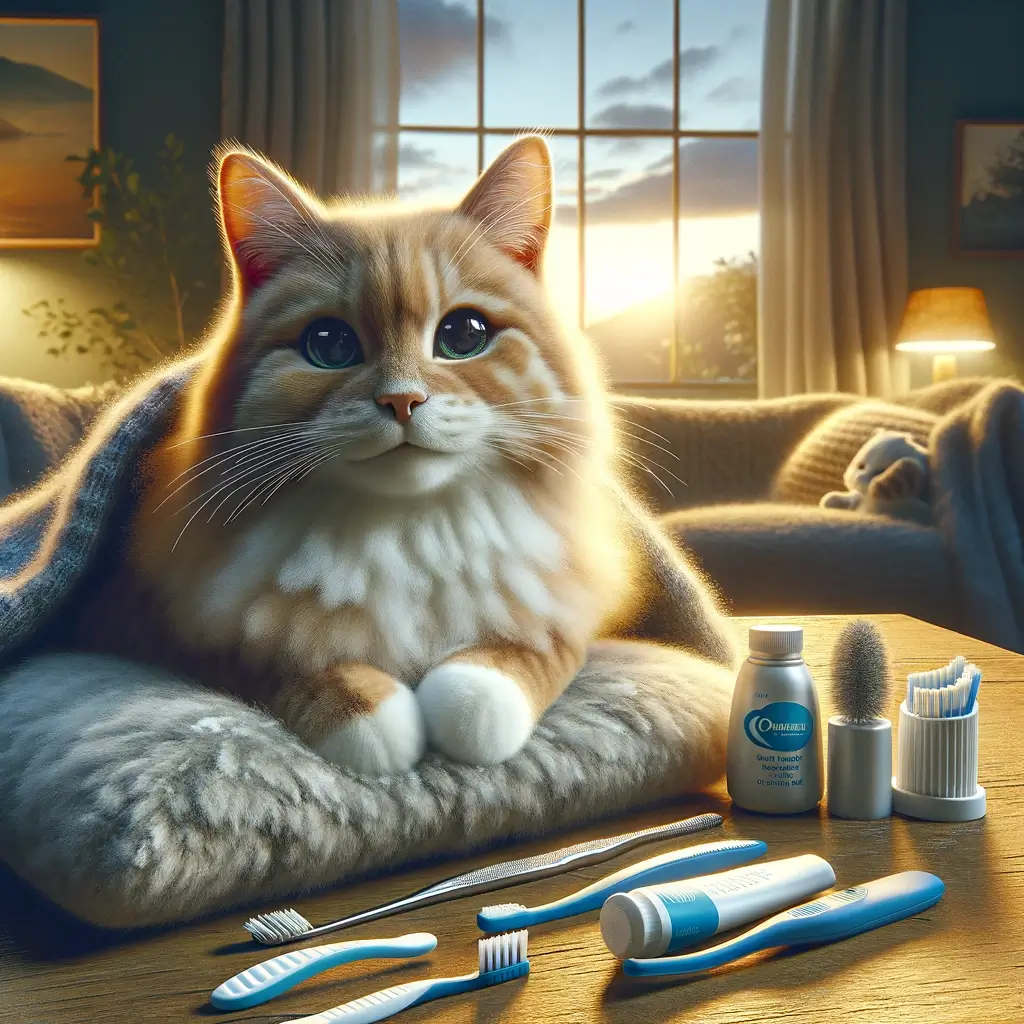
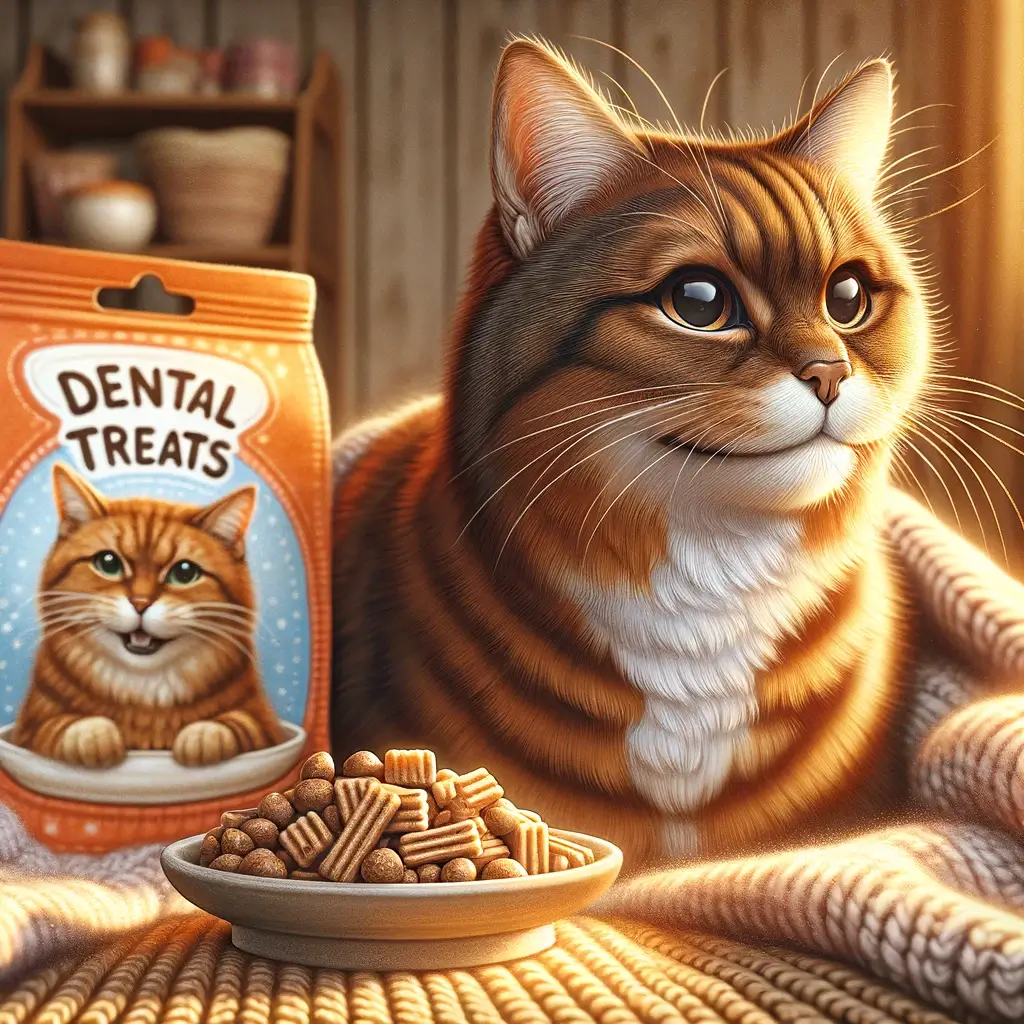
Dental Care at Home vs. Vet Visits
Kicking off at-home dental care for your cat, including brushing teeth and providing dental treats, is straightforward and essential for their health. However, knowing when professional help is needed is just as crucial. Here’s a quick guide.
What You Can Do At Home
Starting with the basics, you’ll need the right tools:
- A cat-sized toothbrush or finger brush.
- Pet-safe toothpaste – remember, human toothpaste is a no-go.
- Dental treats that help reduce plaque and tartar.
The steps to a good brushing routine include:
- Getting your cat accustomed to having its face and teeth touched.
- Introducing them to the taste of pet toothpaste.
- Gently rubbing their gums and teeth with the toothpaste.
- Brushing their teeth softly, tackling one section at a time.
Dental treats also play a role in maintaining dental health by preventing plaque and tartar buildup.
When to Visit the Vet
Despite your best efforts, there are situations when professional help is necessary. If you notice any of the following, it’s time to schedule a vet visit:
- Persistent bad breath even after regular brushing.
- Visible tartar buildup – hard, brown crusts on the teeth.
- Bleeding gums, which might signal periodontal disease.
- Appetite loss or difficulty eating, possibly due to oral pain.
Remember, an annual professional dental cleaning is indispensable for catching problems you can’t at home. Early detection and treatment can prevent more severe health issues, safeguarding your cat’s wellbeing.
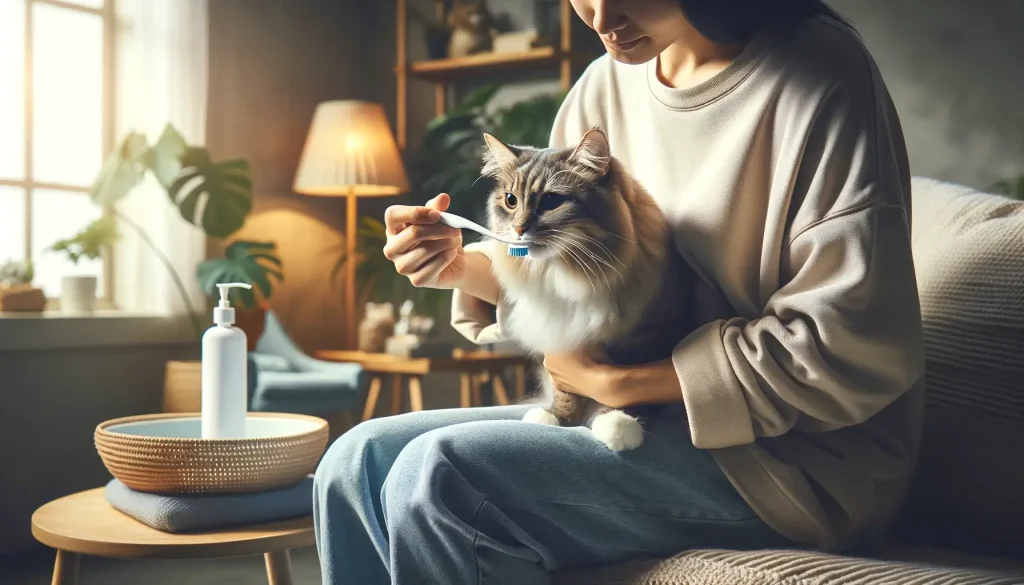
Steps for a Healthy Cat Smile
Keeping your cat’s teeth clean is easier than you think. A routine of daily brushing can prevent the build-up of plaque and tartar, ensuring your cat avoids periodontal disease and maintains good oral health. Here are practical steps to preserve your cat’s pearly whites.
Brushing Made Simple
Start with the right tools: a soft-bristled toothbrush or a finger brush designed for cats, and cat-specific toothpaste. Remember, using human toothpaste is harmful to your pet. Gradually introduce your cat to these tools to make the brushing experience stress-free:
- Gently touch your cat’s face and teeth to get them used to the sensation.
- Let them taste the toothpaste from your finger.
- Apply toothpaste to their gums and teeth with your finger to familiarize them with the texture.
- Softly brush the teeth, focusing on one area at a time to avoid overwhelming them.
Consistency is key. Aim for daily brushing sessions, pairing them with positive reinforcement to create a pleasant routine for both of you.
Pick the Right Dental Treats
Between brushings, dental treats can be a great supplement to your cat’s dental care routine. They help scrape off plaque and can prevent tartar from hardening on teeth. Opt for treats that carry a VOHC (Veterinary Oral Health Council) Seal of Acceptance and always consult your vet before making changes to your cat’s diet or dental care plan.
Regular Vet Check-Ups
Even with diligent at-home care, an annual professional dental cleaning by a vet is necessary. These check-ups can catch issues that aren’t visible to the untrained eye and help prevent the progression of dental diseases.
By introducing a dental care routine early in your cat’s life and sticking with it, you can help ensure your feline friend enjoys a lifetime of good oral health. Taking these simple steps can save your cat from unnecessary discomfort and prevent future health issues, contributing to a happier, healthier life together.
Tackling Plaque & Tartar
Preventing dental issues in cats begins with understanding the enemies: plaque and tartar. But what are they exactly, and why are they harmful to your cat’s oral health?
Plaque is a sticky layer of bacteria that forms on teeth. It’s colorless and can easily go unnoticed until it hardens into tartar. This yellow or brown crusty layer is tougher and clings to the base of teeth. Regular brushing prevents plaque from turning into tartar, thus avoiding the onset of periodontal disease, a severe gum infection that can damage the gums and even destroy the jawbone.
Tools for Effective Dental Care
The key to preventing these dental issues lies in the right tools and techniques:
- Use a soft-bristled toothbrush, sponge toothbrush, or a specialty cat toothbrush that fits on your finger. Choose according to your cat’s comfort.
- Always opt for pet-safe toothpaste. Human toothpaste contains ingredients that can harm your cat.
Step-by-Step Guide to Brushing Your Cat’s Teeth
Effective dental care doesn’t have to be a chore. Here’s a simple guide to keep your cat’s teeth clean:
- Make your cat comfortable with face and teeth touching.
- Introduce pet toothpaste for a taste test.
- Apply toothpaste gently on gums and teeth.
- Brush their teeth gently, one section at a time to avoid overwhelming them.
Dental treats also play a crucial role in your cat’s oral health regimen. These treats are designed to scrape off plaque and are an excellent supplement between brushings. Look for products with a VOHC Seal of Acceptance or consult with your vet for recommendations.
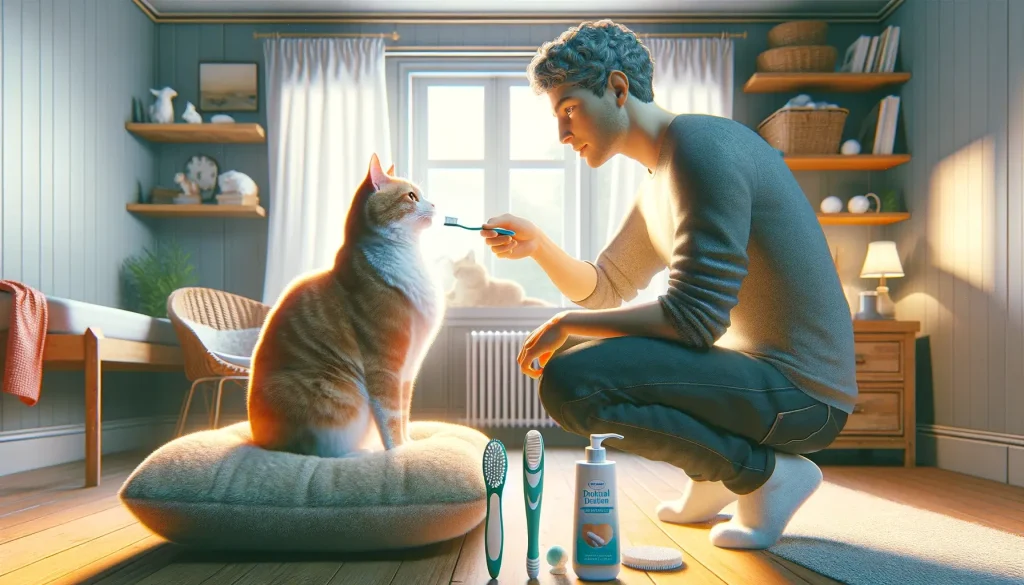
FAQs About Cat Dental Care
Here are answers to some of the most frequently asked questions about cat dental care to help you maintain your furry friend’s pearly whites.
| Question | Answer |
|---|---|
| Why is it important to brush my cat’s teeth? | Brushing removes plaque and prevents it from hardening into tartar, which can lead to periodontal disease. This disease can severely affect your cat’s health beyond just bad breath. |
| How often should I brush my cat’s teeth? | For optimal dental health, it’s recommended to brush your cat’s teeth daily. Regular brushing can save you money on vet bills and prevent serious dental issues. |
| What if my cat hates being brushed? | Start by using a clean washcloth or gauze to get them used to the sensation. Introduce a feline-friendly toothpaste gradually. Some cats may never fully accept a brush, but alternative methods can still help. |
| Can I use human toothpaste on my cat? | No, always use pet-specific toothpaste. Human toothpaste contains ingredients that are harmful if swallowed by cats. |
| Are dental treats effective for cleaning? | Yes, specially designed dental treats can help reduce plaque and tartar buildup between brushings. Look for products with a VOHC Seal of Acceptance for best results. |
Beginner Guide to Raising Quail at Home
What are the Signs of a Dog Concussion?
What Causes Your Dog’s Ears to Smell Bad?
When your dog’s ears start to emit an unpleasant odor, it might leave you puzzled…
Methimazole Treatment for Cat Hyperthyroidism
Methimazole plays a crucial role in managing feline hyperthyroidism, a condition marked by an overactive…
Got Hummingbirds in your Backyard? Here’s How to Care for Them.
Why Does Your Cat Pee Outside the Litter Box?
Cat’s Litter Box Issues It’s not uncommon for cat owners to face the frustrating dilemma…


